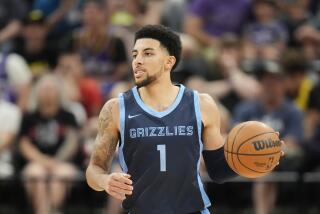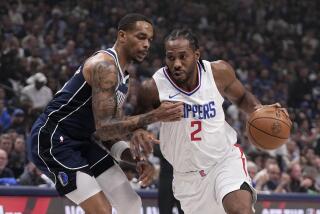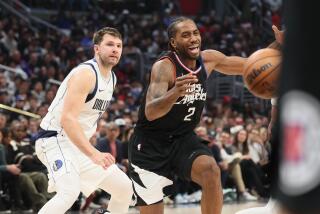Grizzlies overpower Clippers in the paint in Game 2
MEMPHIS, Tenn. — That painted stretch of hardwood that sits below the rim is a mighty concern for anyone who plays Memphis. The Grizzlies averaged about 45 points per game during the regular season in that area, the fifth-most in the NBA.
In Game 1 of their Western Conference first-round playoff series here Sunday, the Clippers, well aware of Memphis’ prowess in the paint, won that category, 54-38, and, you guessed it, the game as well, 99-98.
But in Game 2 here Wednesday, the Grizzlies fell back into their old ground-and-pound habits, scoring 46 points in the lane, while the Clippers managed 38.
And, wouldn’t you know it, Memphis also won the game, 105-98, to even the series, 1-1, as it shifts to Los Angeles, where Game 3 will be played Saturday at Staples Center.
“That’s what they do,” Clippers Coach Vinny Del Negro said. “They pound you inside. They’re an inside team.”
True, and with the inside presence of All-Star center Marc Gasol and power forward Zach Randolph, Memphis boasts a frontline that’s hard to top.
Yet they weren’t the ones who beat the Clippers down low.
Gasol had only eight points and Randolph, with 15, was outscored by three of his teammates.
So, how exactly did Memphis score inside so effectively Wednesday compared with Sunday, especially when its star duo played, on offense, rather mildly?
There are a few factors, but a defensive over-adjustment by the Clippers is a key one.
In Game 1, Memphis made 11 of 16 three-point shots, a high percentage for any team but especially for the Grizzlies, a team that attempts 12.9 three-point shots per game, the 28th-lowest such average out of 30 NBA teams.
To put it simply, Memphis scores from the inside, not outside.
That the Grizzlies made several shots from beyond the arc in Game 1 was a bit of an anomaly, and Memphis Coach Lionel Hollins stressed this point to his team before Wednesday’s game.
“We weren’t going to shoot 11-of-16 from the three-point line because we’re not a three-point shooting team,” Hollins said.
The Clippers seemed to think that the Grizzlies were a three-point shooting team on Wednesday, focusing more on pressuring shooters on or near the perimeter instead of trying to keep driving guards out of the lane or be just physical around the basket.
For the Clippers, this didn’t go over so well.
Not at all, in fact.
Yes, Memphis made just two of its 12 three-point shots.
But the Grizzlies dominated on the glass, outrebounding the Clippers, 37 to 28, including 16 offensive rebounds while the Clippers grabbed just four.
“We’ve got to be a little bit more physical in terms of our rebounding,” Del Negro said.
The Grizzlies also dominated in having players, such as Rudy Gay, who scored 21, cut through the paint for short-range shots.
“They just made an effort to get inside and really feed their bigs and hit cutters and all that,” said forward Blake Griffin. “That was the biggest difference.
“They played the way they always play. We’ve got to do a better job of keeping them out of the paint, or at least making it harder for them.”
The Clippers were unable to slow Memphis’ offensive scheme, which ground and pound them up as it was designed, and the Clippers could only foul in some instances.
That didn’t help.
Memphis shot 39 free throws and made 31 of them.
The Clippers shot 18 free throws and made 13 of them.
After the game, asked why the Clippers were unable to control the paint in the second game as they had in the first, center DeAndre Jordan confirmed that his team’s defense had too many priorities.
“I guess us just trying to take away everything” made the inside defense less effective, Jordan said.
Playoff series are always chess matches, with each team making adjustments from game to game. Expect the Clippers to make a few more after their most recent performance, and expect them to be in direct opposition of how its defense played in the paint.
twitter.com/baxterholmes
More to Read
Go beyond the scoreboard
Get the latest on L.A.'s teams in the daily Sports Report newsletter.
You may occasionally receive promotional content from the Los Angeles Times.










